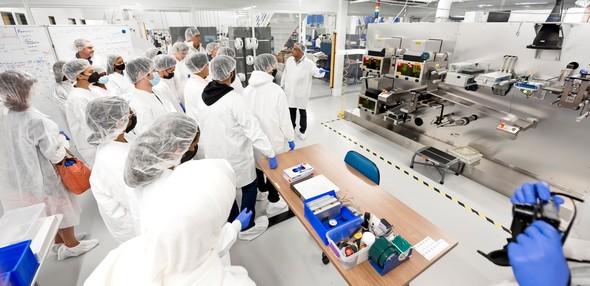How Fremont became a national hotspot for battery development and manufacturing
.png?sfvrsn=ca52a9c9_1) This year, 84% of new electric generation capacity in the U.S. will come from clean energy, with two-thirds likely coming from solar and wind power. More notable, however, is the leap in grid-scale battery installation. Over 16.5% of new generation capacity is anticipated to come from batteries, going from relatively nonexistent just a few years ago to now surpassing the new natural gas generation in the US.
This year, 84% of new electric generation capacity in the U.S. will come from clean energy, with two-thirds likely coming from solar and wind power. More notable, however, is the leap in grid-scale battery installation. Over 16.5% of new generation capacity is anticipated to come from batteries, going from relatively nonexistent just a few years ago to now surpassing the new natural gas generation in the US.
While the sudden surge of battery adoption may seem like it arrived overnight, it comes after years of painstaking efforts by countless startups — many of them in Fremont — to develop new battery cell architectures and the even more challenging process of producing these battery cells at scale.
Over the years, Fremont city staff have amassed unrivaled expertise in understanding the needs of advanced technology industries, including permitting their highly complex operations and providing programmatic oversight for hazardous material management. For battery technology upshots, this expertise has proven particularly valuable.
With the climate crisis worsening, more local efforts like this are needed, be it for battery development or other types of clean energy technology. While not every community can capture investment from the present cleantech boom, Fremont (pop. 230,504) can provide a model for other cities looking to develop their own industry clusters.

Equipping Fremont to support a thriving battery industry
Fremont has seen its share of manufacturing boom and bust cycles, starting with the General Motors/NUMMI plant, which opened in 1962 and ran 48 years before shuttering in 2010. In the intervening years, Fremont has witnessed, weathered, and benefitted from shifts in semiconductor manufacturing, solar technology, and other industries.
Fortunately, neither the city nor its industry base remained static. NUMMI’s closure paved the way literally and figuratively for Tesla to become what it is today. Soon after its closure, the plant reopened as the Tesla Factory. In 2022, the factory became the highest output auto plant in North America, with Tesla growing its Fremont workforce to over 30,000 employees — a 100-fold increase over 12 years. Facilitating this exponential growth was a significant undertaking and priority for the city, with the company submitting as many as a dozen new construction permit applications on a single workday.
While unmatched in size or stature, Tesla is only one of the hundreds of advanced manufacturing companies in Fremont, often referred to as the city’s “manufacturing ecosystem.” This ecosystem is the result of focused efforts by the city to develop and maintain policies that support the industry, including modernized zoning laws that facilitate emerging industries, investments in the permit review process and staff training, and innovative workforce programs that meet businesses where they are.
After manufacturing at the NUMMI plant resumed, Fremont quickly mobilized to make all aspects of the electric vehicle industry — manufacturing, research and development, sales, service, repair, and charging hubs — allowed by right across the city’s industrial zoning districts. The guiding philosophy was simple: The city wanted to capture as much investment from this budding industry as possible, so removing regulatory barriers within the city’s local control was an obvious place to start. As Tesla suppliers, competitors, and new cleantech startups began to look toward Fremont, the city extended those allowances to encompass nearly all facets of the cleantech supply chain, including batteries.
The city’s industry-recognized hazmat program also played a critical role in attracting new battery startups. In 1997, Fremont became one of the first cities to administer its own state-certified Hazardous Materials Management (CUPA) program, a decision to retain local control for the benefit of its manufacturing sector.

This commitment brought seven separate state and federal regulatory programs in-house with centralized government accountability, allowing applicants to work collaboratively with the city’s fire prevention staff. Fremont remains one of a handful of regional cities to administer its own CUPA program, which continues to be a key part of its business attraction and retention strategy.
To alleviate costs for manufacturing businesses operating at scale, Fremont also maintains a low city business tax and does not have a utility user’s tax or a construction tax on tenant improvements.
To provide contemporary space for manufacturing companies, the city established objective development criteria to allow for simple, ministerial, staff-level design reviews of new industrial projects. This has resulted in over 2.5 million square feet of new industrial buildings in the last several years. The city also ensures that incompatible uses do not encroach into industrial areas, a strategy critical for battery companies looking to scale operations.
Read the full story in the May issue of Western City magazine.
The Cal Cities #LocalWorks initiative shines the spotlight on examples of local actions that are making a difference to their communities. Show how #LocalWorks in your community by contacting communications@calcities.org.
